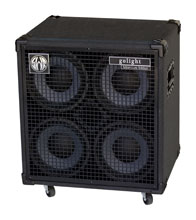What Amp do you like for Fretless?
Posted: Sun Mar 04, 2007 7:40 pm
Let's hear your ideas and opinions on Amps and Cabs that work well for fretless.
WELCOME TO THE NEW FRETLESSBASS.COM BOARD! Please use this board going forward. The old board is still up in read-only mode. This new board has a complete history of posts and users and will soon be a part of our complete new website redesign! Thank you!
http://fretlessbass.com/board/phpBB3/
So if a big amp has something you like, get it, and a truck.Acoustic 360
In the late ’60s, as venues grew ever larger and technology continued to advance, bass amplifier design began to mature. To provide the high output required for proper bass reproduction, designers at a new company called Acoustic Control Corporation attacked the challenge from two directions.
First, to minimize the amplifier overload caused by high-volume playing, they designed a 200-watt RMS solid-state power amplifier. Although using high-power amplifiers for low frequency reproduction with low distortion became de rigeur in the mid-’70s, it was a bold design step at the time. Then, taking a page from high-fidelity speaker designers, Acoustic’s engineers produced a folded-horn speaker enclosure loaded with a massive 18" driver. Besides extending the useful frequency response of the amp, this design was more efficient than sealed-box systems. Again, while such enclosures had been used for years in large theatre sound systems, this was new for an instrument amp. The large (48" x 24" x 18") speaker cabinet featured e" plywood with sturdy tongue-and-groove construction, and it was equipped with dual handles and casters for “dolly-like” handling.
The 360’s power amp was located in the bottom of the speaker enclosure, and the head contained only the one-channel preamp, designed for bass use exclusively. Front-panel controls included a BRIGHT/NORMAL switch and knobs for volume, treble, bass, VARIAMP, fuzztone, and an electronic tuning fork. (Remember: There were no handheld tuners in those days.) The bass and treble controls were boost-only circuits, so full-off was flat, and the VARIAMP controls constituted what was, in effect, the first on-board parametric equalizer: the RANGE knob provided a choice of one of five single-octave frequency ranges, which could then be cut or boosted with the EFFECT control.
Since the projection of the folded-horn box made it noticeably louder at a distance than onstage, an output jack (with crossover) was included for an additional speaker system to extend and smooth the mid- and high-frequency capabilities. The Acoustic 360 featured better low-frequency response, less distortion, and greater efficiency than anything on the market at the time, and it was the first truly professional-quality bass amplifier.

The SWR Goliath™ Series created the modern standard for bass instrument sound reproduction. Now the same painstaking attention to detail has been applied to our line of professional neodymium speaker enclosures—the golight™ series.
These high-quality, lightweight enclosures are the result of a painstaking process in which every component of our Goliath Series was evaluated and, whenever possible, a new lightweight high-performance component was selected for use in our golight enclosures.
We are also proud to have worked extensively with Marcus Miller to develop the first SWR artist model bass speaker enclosure. The Marcus Miller golight is a unique “sealed” 4x10 cabinet designed to deliver the tight, punchy midrange response that Marcus favors. The Marcus Miller golight 4x10 is a non-ported enclosure, 800 watts handling, custom SWR neodymium speakers, horn tweeter with attenuator, Speakon® and 1/4” speaker jacks, removable casters, side handles, vibration-free shock-mounted grill. 55 lbs. (24.9 kg) Impedance: 4 ohms.
Solid tone in a lightweight package. So golight today—less work on your way to play!
The only negative factor so far is Rat Fur covering.Model Name Marcus Miller golight™ 4X10
Model Number 4415510400
Series golight™ Series
Type Bass Speaker Enclosure
Description Extremely Lightweight Sealed 800 watt, 4 ohm, 4x10 Speaker Enclosure with Tweeter.
Features Sealed Non-Ported Cabinet Design for Tight Punchy Midrange
Spring Loaded Rubber Grip Handles
Grey Ozite Carpeting with Stack Lock Corners
Black Heavy Duty Stamped Steel Shock-Mounted Vibration-Free Grill
High Quality Metal Input Panel with Heavy-Duty Attenuator
Two 1/4" and Two Speakon® Speaker Input/Output Jacks
Horn Protection Circuit
Removable Casters
Impedance (Ohms) 4 ohm
Speakers (4) Custom-Designed SWR 10", 4 ohm Neodymium Drivers Manufactured by Eminence®, P/N 0076017000,
(1) Foster® Horn, P/N 0048847000
Controls High Frequency Attenuator
Covering Grey Ozite Carpet Covering with Black Stamped Steel Vibration-Free Grille
Weight 55 lbs. (24.5 kg)
Dimensions Height: 23.5" (59.7 cm),
Width: 23" (58.4 cm),
Depth: 18.375" (46.7 cm)
Power Handling 800 Watts RMS
Accessories Removable Casters P/N 0056483000
Cover Uses Cover P/N 0066171000, US MSRP $49.95 (Not Included)
Frequency Response 105 dB SPL @ 1W1M (-3dB @ 40Hz and 15KHz)
SPL 105 dB SPL @ 1W1M (-3dB @ 40Hz and 15KHz)
Introduced 1/2009